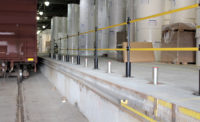Potential safety concerns loom around every corner in refrigerated food facilities, freezer storage warehouses and virtually any type of distribution center.
As forklifts and pedestrians move among machinery and valuable product, the risk of injury and damage is significant when left uncontained. To mitigate these risks, many facilities implement visual communication systems, barriers or a combination of both.
While painted yellow lines serve as a visual reminder of work and pedestrian zones, they can easily be missed. Physical barriers are much harder to ignore.
Beyond separating employees from automated processes and dangerous workspaces, barriers may also be used to protect production equipment and/or the building itself from damage by wayward forklifts and automated guided vehicles (AGVs).
In some situations, movable barriers are being employed. For example, in facilities that need to separate two temperature zones, high-speed doors and blast freezer doors are often implemented, as they can make for safer and more efficient operations than other types of doors or barriers.
Barrier basics
Most pedestrian pathways in food plants are designated with painted yellow lines. Increasingly, these visual cues are augmented with physical barriers to provide an additional layer of safety in areas where frequent forklift traffic occurs. This isn’t surprising, since workplace injuries accounted for nearly $206.1 billion a year , according to most recent annual data from the National Safety Council, Itasca, Ill.
Heavy equipment operation zones are one of the most dangerous areas in any plant. Roughly 20,000 people are seriously injured and 100 killed every year in forklift-related incidents across the U.S., according to the National Institute of Occupational Safety and Health, Atlanta. The barriers used in these applications are designed to absorb the energy of a vehicle impact, protecting plant personnel from potentially life-threatening injuries.
Many manufacturers rate industrial barriers based on their ability to stop an impact of 10,000 pounds at 4 mph, which has been an industry standard for more than 30 years. While this rating provides a meaningful reference for a specific load at a specific speed, it fails to define several key variables:
- How is the barrier’s performance affected as the mass of the impacting vehicle increases?
- How is the barrier’s performance affected as impacting vehicle’s speed increases?
- How severely was the barrier damaged by the impact? Is replacement necessary?
- How much did the barrier deflect during impact? Did it stop the load soon enough to prevent injury or damage?
Think about BLAST
To fully address these questions, a new test methodology has been developed to quantify specific application variables and determine barrier ratings in terms of total kinetic energy absorption instead of a specific mass and speed.
Called BLAST (short for ‘’barrier load and speed testing”), it is centered on the formula for kinetic energy (EK = ½mv2, where m=mass [weight] and v=velocity), which takes into account both the weight and speed of the impacting object.
The test separates the barrier’s impact rating into three different areas.
One area shows levels of testing where the barrier wasn't damaged, and is capable of being impacted again. For example, a forklift weighing 17,500 pounds, including the load its carrying, traveling at 3 mph is going to be able to hit a barrier with minimal damage to the barrier, while keeping employees or product on the other side safe.
However, that same forklift traveling at 4 mph will fall into another area, which means the barrier will stop the load, but could potentially sustain damage or inflict injury.
The third area shows where the impact energy exceeds the barrier’s maximum rating. In these cases, for instance, if the 17,500-pound forklift was traveling at 5 mph, the impact from the vehicle cannot be fully absorbed and the barrier would not be able to stop the load, indicating that this barrier should not be used for this application.
High-speed doors improve in-plant safety
Doors also play an important role in facility safety and work zone separation, as well as cold chain integrity. High-speed fabric roll-up doors (also called upward-acting doors) are becoming more popular in food manufacturing facilities due to their forklift-friendly safety design. A forklift collision with traditional, bi-parting doors can lead to driver injury, product or equipment damage and costly downtime due to repair. Fabric doors can withstand forklift impact and snap right back into their tracks, greatly reducing both downtime and energy loss as compared to traditional doors.
The International Energy Conservation Code (IECC) is recognizing the importance of high-speed doors. Its 2015 edition includes a revision to Table C402.4.3, which describes the maximum air infiltration rates for fenestration assemblies. At 1.3 cfm/sf, high-speed doors have the largest rate of infiltration in the table. As a draft copy of the table notes, however, this is because the high-speed nature of these doors provides for minimizing of “air exchange,” a valuable and predominant characteristic of minimizing overall energy losses through a door opening.
Stone cold safety
Blast freezers present their own unique set of door challenges. Also known as “shock” freezers, blast freezers are widely used in the food industry (and some commercial kitchens) to quickly freeze everything from TV dinners to fish to ice cream.
Unfortunately, these massive blast freezers present a threat to in-plant safety for employees and equipment. The size, pressure and frost buildup in many blast freezers often makes the insulated panel doors very cumbersome to move. In some cases, these large doors, which can be as a large as 25 feet by 25 feet, have become so heavy and hard to open that employees have resorted to dangerous methods to open them, such as using a forklift. When left open even a crack, these doors can waste large amounts of energy if not closed properly.
Recently, customized curtain walls have been designed specifically for blast freezers, potentially eliminating the need for heavy and dangerous insulated panel doors. Blast freezer curtain walls are made of insulated, sliding panels nested in a tubular steel frame. Each panel is constructed of 18-ounce, industrial vinyl fabric surrounding a layer of anti-microbial polyester batting.
Engineered to be light and easy to use, blast freezer curtain walls form a safe airflow and thermal barrier and can be operated by just one person. This seal minimizes the buildup of ice on the floor at the base of the doors, reducing the chance of employee injuries from dangerous slips and falls, while also redirecting the chamber’s airflow, reducing blast cycle times and lowering energy consumption.
The bottom line
Preventing injuries and damage to products and equipment is possible with an investment in safety barriers. Whether protecting the cold chain with efficient, safe and flexible refrigerated/freezer doors or separating pedestrians and machinery workspaces, safety barriers solidify facilities.
Food plant managers who consider implementing BLAST, high-speed doors and blast freezer curtain walls will be taking a step toward improving in-plant safety.
No matter the function, barriers are key assets in ensuring facility safety and efficiency.


